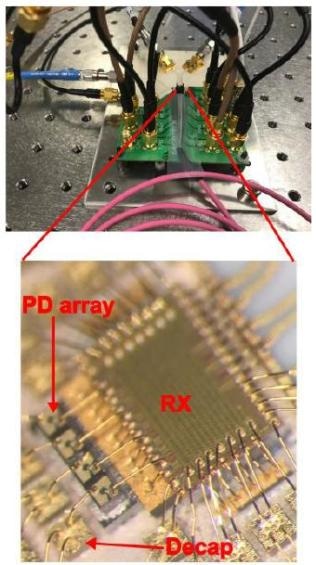Feb 25 2018
With the rapid popularization of data centers and other bandwidth-hungry interconnect applications, present-day bandwidth growth of short-distance optical networks requires data transmission speeds of over 100 Gb/second, calling for the advancement of energy-efficient, multi-channel optical links with rapid data transfer rates.
 This is a photo of the test-setup (top) and the packaged receiver (bottom). (Image credit: Alessandro Cevrero)
This is a photo of the test-setup (top) and the packaged receiver (bottom). (Image credit: Alessandro Cevrero)
Based on complementary metal-oxide-semiconductor (COMS) technology — a basic economical, high-volume chip manufacturing method used for most processors and chips nowadays — a team of researchers from IBM Research in Zurich, Switzerland, along with a consortium working under the EU-funded project “ADDAPT,” have shown a novel optical receiver (RX) that can realize an aggregate bandwidth of 160 Gb/s via four optical fibers.
This is not only the fastest data transmission speed so far, but the newly developed optical receiver also has the link power-on/off functionality and can wake-up and realize phase-lock in eight nanoseconds, the shortest switch time ever. They will showcase their innovation at OFC 2018, 11-15 March, San Diego, California, USA.
According to the team, the rapid power-on/off feature will improve link utilization and significantly decrease energy consumption on a chip or in an optical interconnect system. In contrast to many commercial optical transceivers that are always powered on irrespective of transmission activity, the power here would only be used when data packets are conveyed through the optical link. The unique design, packaged with an 850-nanometer photodiode array, targets economical VCSEL-based optical links for data center interconnects.
This is the first optical receiver that combines high-speed data transmission rate and rapid power-on and off functionality while being extremely low lower in the ‘power-on’ state (about 88 miliwatts).
Alessandro Cevrero, Main Author and scientist of IBM Research Lab, Switzerland
At present, link utilization in datacenters is less than 10% for 99% of the links. This means only 10% of the links’ work time is truly used for conveying user data, while the rest of the time is unused by transmitting idle data packets that missing information. To enhance power efficiency in optical interconnect system, the researchers created the rapid on/off functionality for the receiver, so that links can be powered off during idle time and turned back on when the data is ready to be conveyed.
“Our design, for the first time, allows for the on/off switching of and optical link on a per-packet basis,” Cevrero said. The switch-on time is just eight nanoseconds, which is shorter than the average length of time for an individual data packet in a general network protocol transmitted at a speed of 160 Gb/second. “There were previous scientific attempts to turn off the links when there is no data. However, the timescale to switch on and off the link was orders of magnitude longer than that of an individual data packet. To achieve shorter power-on, time at a very high data transmission speed is the key challenge.”
To look into this, Cevrero’s team developed an optical receiver with four identical channels related with a proposed link protocol. The link protocol is fitted with self-developed smart analog circuits that can quickly align the receiver’s clock with the influx of the incoming data, and detects the optical signal sequences to quickly turn the link system on and off.
The team then tested the receiver at 40 Gb/second with a reference transmitter comprising an 850-nanometer Mach-Zehnder modulator followed by a variable optical attenuator. They also did power on/off experiments by producing an optical signal implementing the planned link protocol.
Consequently, they witnessed correct power cycling across a 109 power cycle, and that the receiver works error-free at 40 Gb/second yielding 160 Gb/second aggregated bandwidth across multi-mode fibers. The experimental data also revealed that 10% link utilization corresponds to 85% power saving on the receiver.
Cevrero observed that enhancing power efficiency of optical links enables scientists to construct considerably faster, higher performance computer systems, as one can “cram” higher bandwidth in the same thermal budget of the package. Minimizing on energy consumption also helps decrease the carbon dioxide emission from the optical network, resulting in greener optical communication systems.
The researchers’ following step, Cevrero said, is to validate a comprehensive optical interconnect system by measuring the optical transmitter, as well as to boost the data transmission speed on the receiver side to 56 Gb/second per channel.
This research received funding from the European Commission through the Seventh Framework Programme (FP7) project ADDAPT (Adaptive Data and Power-Aware Transceivers for Optical Communications, grant 619197).